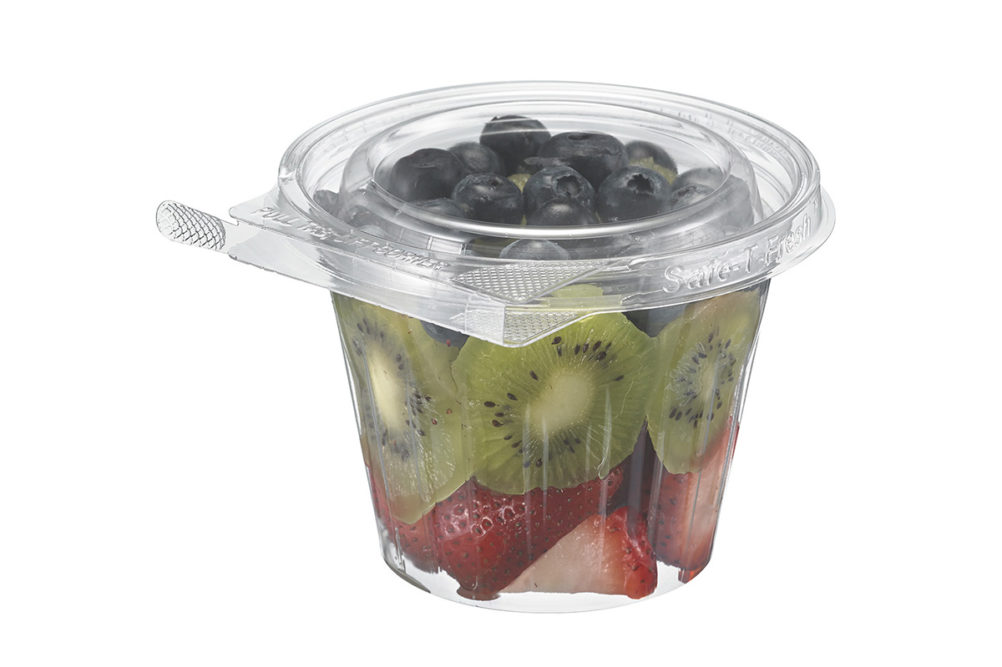Inflation has compelled grocery retailers to keep price points at levels their hard-hit customers can afford. Stocking more single-serve packs is one way of doing just that.
But there are other factors driving the surge in demand for single-serve. Americans’ desire to eat healthier is a huge one, said Kim Radigan, assistant brand manager for Shelton, Conn.-based Inline Plastics Corp.
“The market is moving away from super-size, and focusing more on healthy size. The demand for healthier food options continues to dominate, especially when it comes to snacking and the need for quick, grab-and-go options.”
The larger the package, the more people eat out of it without even realizing it, Radigan said, citing Centers for Disease Control and Prevention (CDC) data. Inline’s expansion of its small, single-serve container offerings is specifically targeted to providing individual, perfectly portioned amounts.
“Portion control is a big component in making better food choices,” she said. “Larger portion sizes are one factor contributing to overeating and unwanted weight gain. Intentional portion control helps prevent overindulging.”
With obesity a growing epidemic, and more people focused on controlling and maintaining their weight, food options that come already packaged in single-serve formats offer a huge advantage, Radigan said.
By offering a wide variety of shapes and sizes in smaller capacities, Inline allows grocers to package fresh cut fruits and vegetables, parfaits, nuts, snacks and even bakery treats in a healthy serving size.
Healthy eating also involves offering options for those with specific dietary needs — like gluten-free, organic or vegan — as well as branching out with unique and ethnic flavor combinations.
“Individual, single-serve packs allow consumers that require or desire these alternatives to purchase only what they need for a single meal or snack,” Radigan said.
Demand for single-serve packaging options has grown as the trend of consumers cooking at home declines from the highs reached during the pandemic, said Adrianne Tipton, chief technology officer for Hartsville, S.C.-based Novolex.
As many people return to the office, Novolex is also seeing an uptick in demand for ready-to-go meals. The reopening of retail salad bars has also contributed to the uptick in demand for these products.
Prepared vegetables, precut fruit, salad kits and prepared sides are among the growing categories in single-serve as consumers look to balance convenience and value, Tipton said.
The Falls Church, Va.-based Foodservice Packaging Institute (FPI) has been tracking shifts in what is most popular in single-serve, said Natha Dempsey, the group’s president.
“As things like catering and the breakfast daypart come back from pandemic lows, we’re seeing a drive towards packaging types that meet needs in those categories,” she said. “Our industry hasn’t been spared from global economic issues, including supply chain disruption and inflationary pressures. The industry is still working to supply their customers with the products it can while these disruptions continue. Innovation is ongoing and we’re seeing more collaboration return to meet the needs of customers.”
Eco-friendly options
Those innovations include material types used in tamper-evident and tamper-resistant packaging, highlighted by more fiber-based packaging, Dempsey said.
Inline is also tracking increased environmental awareness when it comes to single-serve packaging, Radigan said.
Individual servings eliminate food waste, because consumers buy only the right-sized, perfectly portioned amount of food they need, she said. Inline’s PET packaging is 100% curbside recyclable and infused with post-consumer content made from new technology.
“Inline is leading the way by being the first food packaging thermoformer leveraging advanced molecular recycling,” Radigan said.
An option for every occasion
Inline offers a wide range of packaging for single-serve products. In the company’s Essentials line, CrystalFresh is ideal for single servings of baked goods, and VisiblyFresh makes the perfect container for salads and prepared meals, Radigan said.
Inline’s patented, tamper-evident Safe-T-Fresh line, meanwhile, offers a multitude of container options for single servings of yogurts and parfaits, cut fruits and veggies, salads, nuts and other products.
And the company’s Squares line includes multi-compartment options to mix-and-match snacks and dips. Packaging for wraps is another option in the line, which also features a hanging tab that provides retailers another way to attractively and conveniently merchandise single-serve options, Radigan said.
Finally, the introduction of Safe-T-Chef earlier this year is making hot foods available in single-serve sizes. Safe-T-Chef is the first tamper-evident, tamper-resistant polypropylene product family for hot applications, Radigan said.
“Safe-T-Chef adds protection to the contents, especially when using third party delivery services.”
New from Novolex
Several Novolex packaging lines offer single-serve alternatives, many of which were developed to meet pandemic-related demand, Tipton said.
Products in the company’s Blaze line are microwave-safe and can handle both hot and cold food applications. Single-serve bowls from its Waddington North America brand are easy to open and designed to use both high and low dome lid options for different food applications.
Novolex’s Eco-Products Vanguard clamshells, introduced in 2021, are molded fiber containers that use proprietary alternative compounds made from reclaimed and rapidly renewable sugarcane fibers to achieve grease-resistance performance. They also meet BPI requirements for compostability certification.
Eco-Products also offers single-serve containers made with renewable and recyclable materials in a variety of shapes and sizes, perfect for prepared foods, Tipton said.

